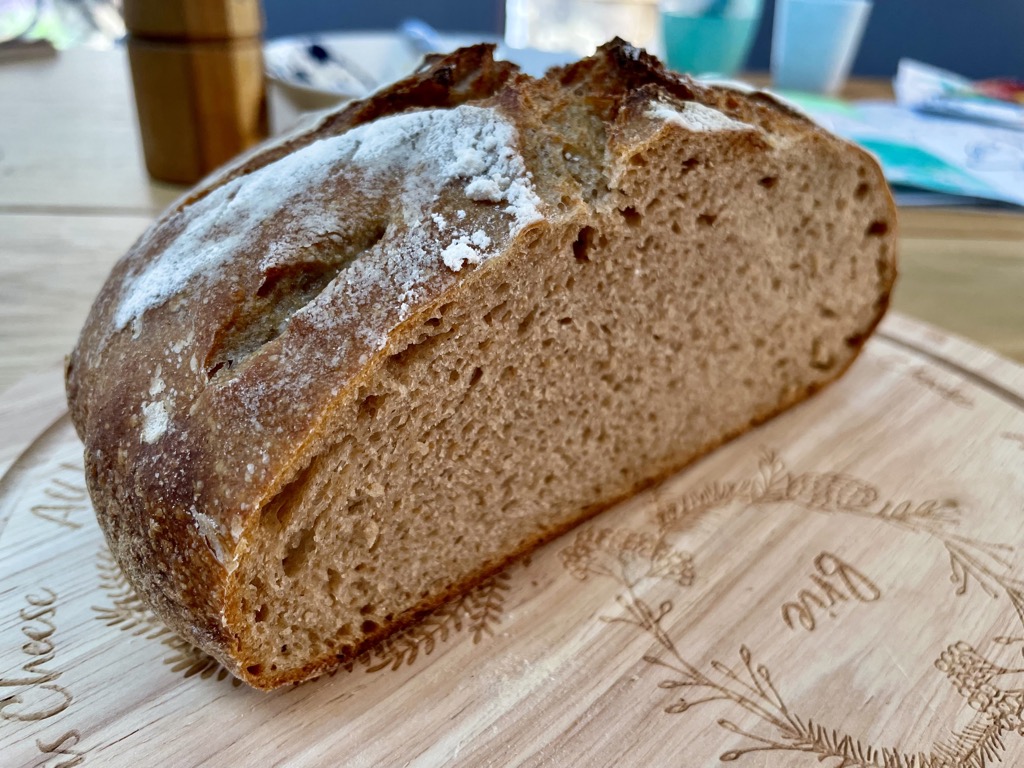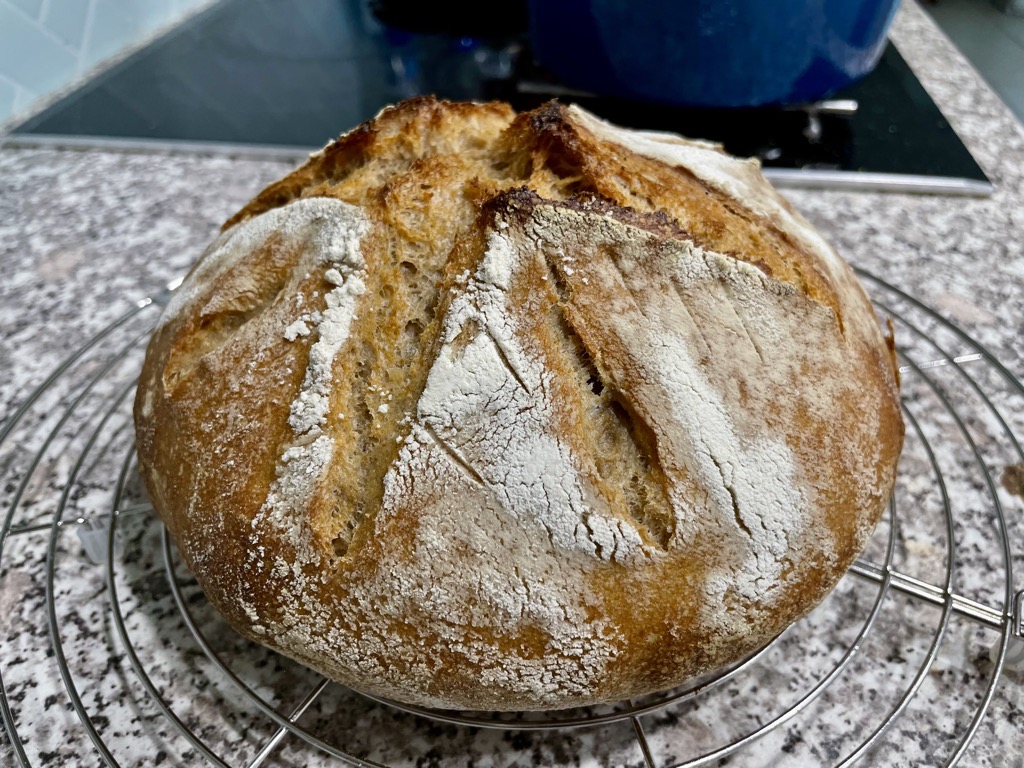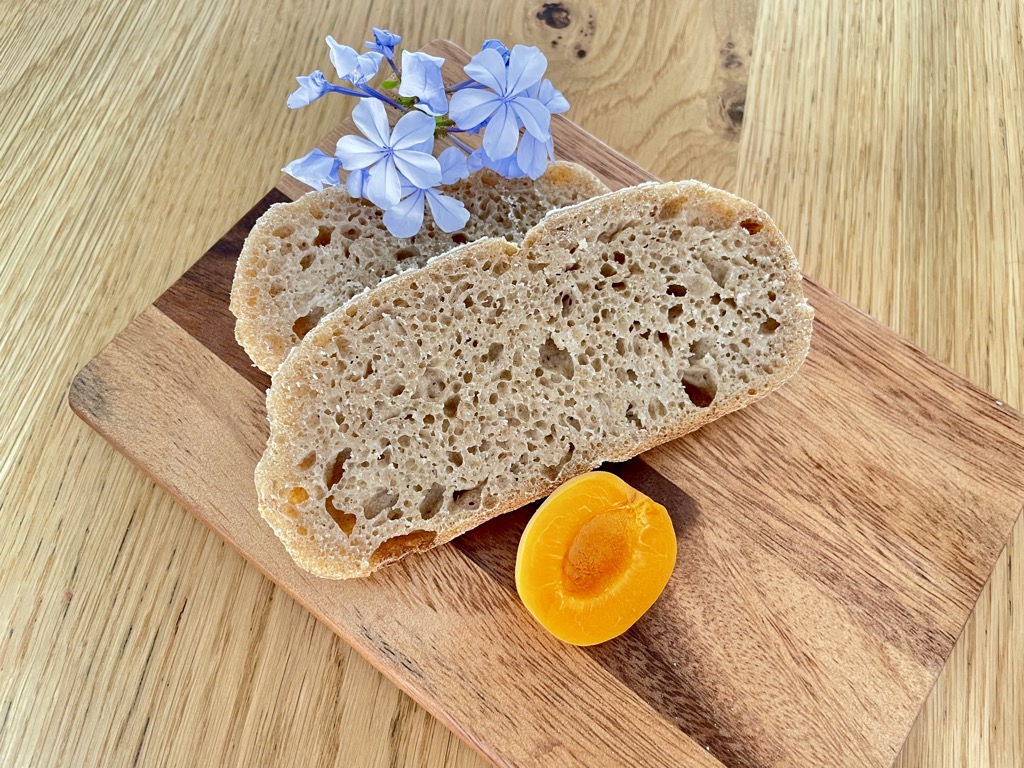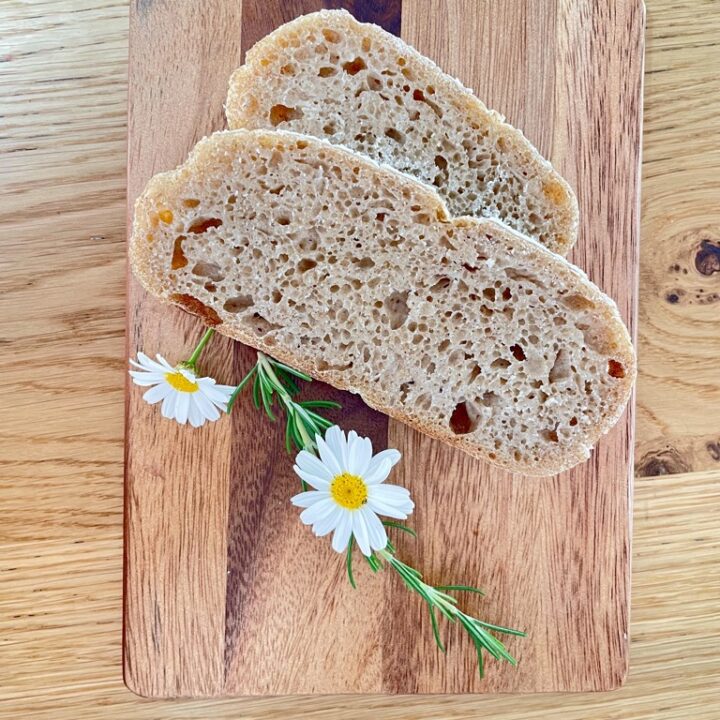Super Easy Whole Wheat Rye Sourdough Loaf
With the weather getting a little more chilly over here in Australia, I want to take a moment to introduce you to a super easy whole wheat rye sourdough loaf recipe. Imagine this: a warm slice of rustic bread, fresh from the oven, steam still rising from it. You dip it in (plant based) butter, sprinkled it with sea salt and take the first bite. Can you taste it? It’s delicious!

There’s something truly magical about baking bread from scratch. It’s a process that’s deeply rooted in tradition, connecting us to past generations who relied on simple ingredients and their own two hands to nourish themselves and their families. In today’s fast-paced world, where convenience often trumps quality, taking the time to bake bread at home is a gentle rebellion—a way of reclaiming a piece of our heritage and embracing the slower, more intentional rhythms of life.
Returning to simplicity
In a world filled with mass-produced, preservative-laden breads, there’s something undeniably comforting about the simplicity of homemade sourdough. With just a handful of basic ingredients—flour, water, salt, and sourdough starter—you can create a loaf that’s not only delicious but also free from artificial additives and unnecessary chemicals. There’s the satisfaction of knowing exactly what goes into your bread and having full control over the process from start to finish. This whole wheat rye sourdough loaf is no exception.
Homemade bread isn’t just about nostalgia and comfort – it’s also about nourishment. I love to add extra nutrients to my meals, any way I can. It’s those everyday battles with my fussy little eaters that have opened my eyes to the many ways of hidden goodness. By incorporating wholewheat and rye flours into our sourdough loaf, we’re not only adding depth of flavour and texture, but also boosting its nutritional profile. Whole grains are rich in fiber, vitamins, and minerals, making them an excellent choice for those looking to improve their overall health. The fermentation process involved in sourdough baking also helps to break down gluten and other potential irritants, making it easier to digest for those with sensitive tummies.

The joy of slow living
One of the things I love most about baking bread at home is the way it encourages us to slow down and enjoy the moment. While the outside world constantly pushes us to do more, be more, achieve more, there’s something profoundly grounding about taking the time to knead dough, watch it rise, and savour the aroma as it bakes. It’s a reminder that life isn’t just about ticking items off our to-do lists—it’s about finding joy in the simple, everyday moments that are the essence of our existence.
For many of us, the kitchen is more than just a place to prepare meals. It’s a place to create memories, bond with loved ones, and express our creativity. Baking bread, in particular, has a way of bringing people together, whether it’s kneading dough with your kids, sharing recipes with friends, or gifting a freshly baked loaf to a neighbour. There’s a sense of warmth and camaraderie that fills the air when bread bakes in the oven, turning even the most ordinary of days into something special.
Few things bring me more joy than sharing a freshly baked loaf of bread with friends and family. Whether it’s breaking bread together over a leisurely weekend brunch, packing sandwiches for a picnic in the park, or simply dropping off a loaf on a loved one’s doorstep, there’s something incredibly heartwarming about sharing the fruits of your labor with others. It’s a simple yet profound act of generosity. One that has the power to nourish not only the body, but also the soul.

Get started today
Whether you’re a seasoned baker or a novice in the kitchen, I encourage you to give sourdough baking a try. Start with simple loaves and slowly incorporate your different grains. It’s not just about making bread. It’s about embracing a simpler way of life, reconnecting with tradition, and finding joy in the simple act of creation. So roll up your sleeves, dust off your apron, and let’s bake some memories together. Happy baking!
Tools you need
Small bowl to feed your starter
Large mixing bowl
Stand mixer
Kitchen scales
Wooden spoon
Proofing basket or small bowl and tea towel for dough to rise
Tea towel
Bread lame or sharp knife
Dutch oven for baking
Wire rack

Ingredients
- Active sourdough starter
- White bakers flour
- Whole wheat flour
- Rye flour
- Salt
- Water
How to bake a Whole Wheat Rye Sourdough Loaf
Start by giving your sourdough starter a little love. I take around 60g out of my large jar of fridge kept starter and feed it in a separate bowl. This allows me to only feed the exact amount I need. It also avoids me having a huge jar of discard to get through. Once measured, feed your starter with equal parts flour and water and let it sit until it’s nice and bubbly. This usually takes about 4-6 hours, depending on the temperature of your kitchen. If you are unsure of your starter being ready yet, take a small amount and place it in a glass of water. If your starter floats it’s ready. If it sinks, give it a bit longer.

Once your starter is all bubbly and happy, it’s time to mix up the dough. In a large bowl, combine the bubbly starter, wholewheat flour, rye flour, white bakers flour, water, and salt. Using a dough hook, mix everything together until your dough passes the windowpane test. If you are not familiar with the term – it involves stretching a small piece of dough until it forms a thin, translucent membrane. This indicates that the gluten has developed sufficiently for proper structure and texture in the finished bread.
Once your dough is nice and smooth, turn your stand mixer off and remove the bowl. Keep your dough in the bowl for the time being. Cover it with a kitchen towel and let it rise on the kitchen bench for about 3 hours, or until it’s doubled in size.
Shaping your whole wheat rye sourdough loaf
After the dough has had its rise, sprinkle a chopping board or your clean kitchen bench with flour. Take your dough out of the bowl, place it on the floured surface and gently shape it into a nice, round loaf.
Add flour to your proofing basket or a bowl lined with a clean kitchen towel. Rub the flour all over the fabric until it is slightly coated in flour. Place the dough into the bowl with the bottom or “ugly” part of the ball on top. Cover the bowl with a clean kitchen towel and pop it in the fridge to let it rest overnight. This slow rise in the fridge will develop those delicious flavors and give your loaf that classic sourdough tang.

The next day
The next day, preheat your oven to 240 degrees Celsius (about 475 degrees Fahrenheit). Place your dutch oven including lid into the oven while it is heating up. This will allow for a hot baking dish and the ideal environment for your loaf.
While the oven is heating up, carefully remove the dough from the fridge and transfer it to a chopping board. Using a bread lame, sharp knife or razor blade, score the top of the loaf with a few shallow slashes. This will help the loaf expand in the oven and give it that beautiful artisanal look. If you are new to sourdough baking, try a single long line or cross in the middle of your loaf.
Now for the fun part! Once your oven hits 240 degrees, place the loaf in a preheated Dutch oven and cover it with the lid. Bake for 20 minutes, then remove the lid and bake for an additional 10 minutes, or until the loaf is golden brown and crusty. To test, give the bottom of your loaf a knock. It should sound evenly hollow if baked through.
Once your loaf is done baking, transfer it to a wire rack and let it cool completely before slicing into it. I know, waiting is the hardest part, but trust me, it’s worth it! Slice it up, slather on some butter, jam or (my favourite) Nutella and enjoy your homemade whole wheat rye sourdough loaf with your family over rosemary infused carrot soup. Bon appétit!

Tips for making Whole Wheat Rye Sourdough Bread
- Rye is a very heavy, thirsty flour which will need special attention the more you add to your dough. Its high enzyme content causes starches to break down faster, and your loaf to turn gummy if used in larger quantities. As such, it is recommended to use no more than 25% rye flour in your bread dough until you are comfortable with the process, consistency and steps involved in bread baking.
- While the above amount of water seems to work well for the type of flour I use, you may want to start with a little less and add more water as your dough comes together. As a general rule of thumb, I add just enough water for my dough to “slip” in the bowl.
- If you are using a “thirsty” flour, the amount of water mentioned in the recipe may not be enough. Continue to add a little water until your dough becomes quite sticky at first, and then allow your stand mixer to work its magic and bring it all together.
- Rye flour is incredibly nourishing for your sourdough starter. Every once in a while, when my starter looks a little flat, I feed my starter with Rye flour to bring it back to life.
- I like to keep sourdough baking pressure-free and feed only a small amount of starter ahead of baking. This avoids me having a huge amount of active starter or discard I won’t use in time. Simply take a third of the amount of starter you need out of your starter jar and feed it in a small bowl to achieve the full amount and reduce waste.
Frequently asked questions
Is rye or whole wheat better for sourdough?
Both rye and whole wheat can be used to make delicious sourdough bread. The choice depends on your personal preference. Rye flour tends to create a denser, darker loaf with a stronger flavor, while whole wheat flour adds a nuttier taste and slightly denser texture compared to white flour. Experiment with both to find what you prefer in terms of taste and texture.

Can you use wholemeal rye flour for sourdough starter?
Yes, you can absolutely use wholemeal rye flour to create a sourdough starter. Rye flour tends to be more active in fermentation compared to wheat flour, which can help kickstart your sourdough culture. Just keep in mind that rye flour absorbs water differently than wheat flour, so you may need to adjust your feeding ratios accordingly.
Can I use rye flour instead of whole wheat for sourdough?
You absolutely can, yes. Since rye flour is very thirsty your recipe quantities may need to be adjusted though. Due to its density it is also recommended to use no more than 25% rye flour in a recipe. Follow this guide until you are comfortable to cater to the special needs of increased amounts.
Is rustic sourdough bread good for you?
Rustic sourdough bread can be a healthy choice, especially if it’s made with whole grain flours like whole wheat or rye. Sourdough fermentation can make the bread easier to digest. It can also lead to a lower glycemic index compared to bread made with commercial yeast. Additionally, whole grain flours provide fiber, vitamins, and minerals that are beneficial for your health.
Does rye make sourdough more sour?
Yes, rye flour can contribute to a more sour flavor in sourdough bread. Rye flour contains more natural sugars and nutrients that yeast feeds on during fermentation. This can lead to a more pronounced sour taste compared to bread made solely with wheat flour. Additionally, rye flour tends to ferment more quickly than wheat flour, which can also enhance the sourness of the final bread.

Super Easy Whole Wheat Rye Sourdough Loaf
Learn to bake a super easy rustic loaf with this Whole Wheat Rye Sourdough Recipe.
Ingredients
- 160g Active sourdough starter
- 200g White bakers flour
- 100g Whole wheat flour
- 100g Rye flour
- 10g Salt
- 230g Water
Instructions
- Start by giving your sourdough starter a little love. I take around 60g out of my large jar of fridge kept starter and feed it in a separate bowl. This allows me to only feed the exact amount I need and avoids me having a huge jar of discard to get through. Once measured, feed your starter with equal parts flour and water and let it sit until it's nice and bubbly. This usually takes about 4-6 hours, depending on the temperature of your kitchen. If you are unsure of your starter being ready yet, take a small amount and place it in a glass of water. If your starter floats it’s ready. If it sinks, give it a bit longer.
- Once your starter is all bubbly and happy, it's time to mix up the dough. In a large bowl, combine the bubbly starter, wholewheat flour, rye flour, white bakers flour, water, and salt. Using a dough hook, mix everything together until your dough passes the windowpane test. If you are not familiar with the term - it involves stretching a small piece of dough until it forms a thin, translucent membrane, indicating that the gluten has developed sufficiently for proper structure and texture in the finished bread.
- Once your dough is nice and smooth, turn your stand mixer off and remove the bowl. Keep your dough in the bowl for the time being. Cover it with a kitchen towel and let it rise on the kitchen bench for about 3 hours, or until it's doubled in size.
- After the dough has had its rise, sprinkle a chopping board or your clean kitchen bench with flour. Take your dough out of the bowl, place it on the floured surface and gently shape it into a nice, round loaf.
- Add flour to your proofing basket or a bowl lined with a clean kitchen towel. Rub the flour all over the fabric until it is slightly coated in flour. Place the dough into the bowl with the bottom or “ugly” part of the ball on top. Cover the bowl with a clean kitchen towel and pop it in the fridge to let it rest overnight. This slow rise in the fridge will develop those delicious flavors and give your loaf that classic sourdough tang.
- The next day, preheat your oven to 240 degrees Celsius (about 475 degrees Fahrenheit). Place your dutch oven including lid into the oven while it is heating up. This will allow for a hot baking dish and the ideal environment for your loaf.
- While the oven is heating up, carefully remove the dough from the fridge and transfer it to a chopping board. Using a bread lame, sharp knife or razor blade, score the top of the loaf with a few shallow slashes. This will help the loaf expand in the oven and give it that beautiful artisanal look. If you are new to sourdough baking, try a single long line or cross in the middle of your loaf.
- Now for the fun part! Once your oven hits 240 degrees, place the loaf in a preheated Dutch oven and cover it with the lid. Bake for 20 minutes, then remove the lid and bake for an additional 10 minutes, or until the loaf is golden brown and crusty. To test, give the bottom of your loaf a knock. It should sound evenly hollow if baked through.
- Once your loaf is done baking, transfer it to a wire rack and let it cool completely before slicing into it. I know, waiting is the hardest part, but trust me, it's worth it! Slice it up, slather on some butter, jam or (my favourite) Nutella and enjoy your homemade whole wheat rye sourdough loaf with your family. Bon appétit!
